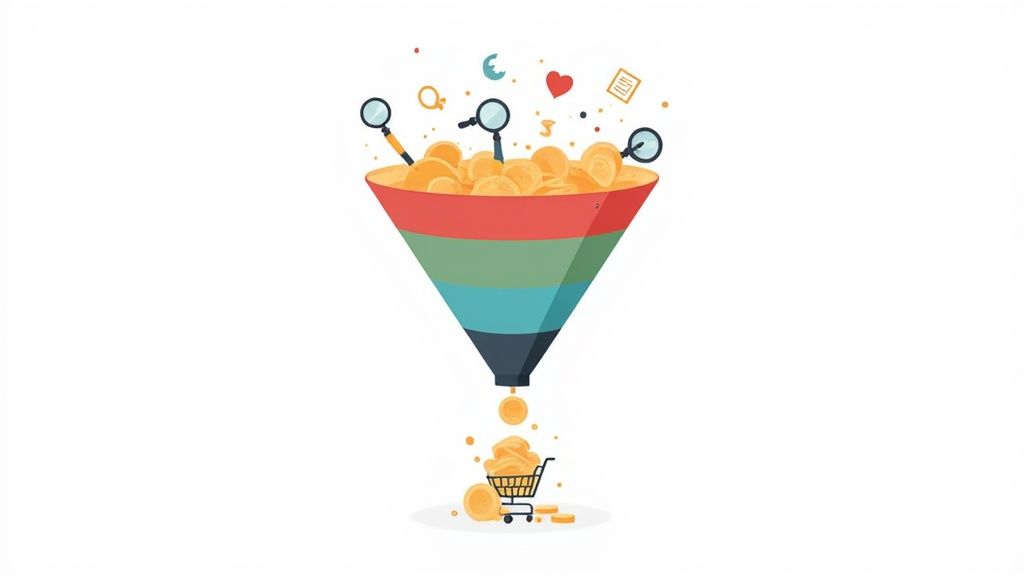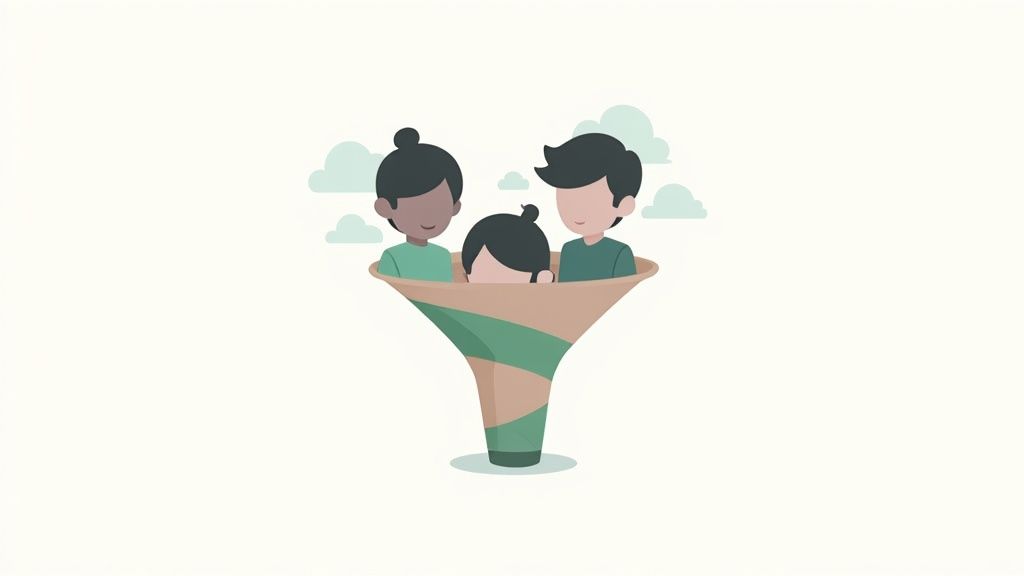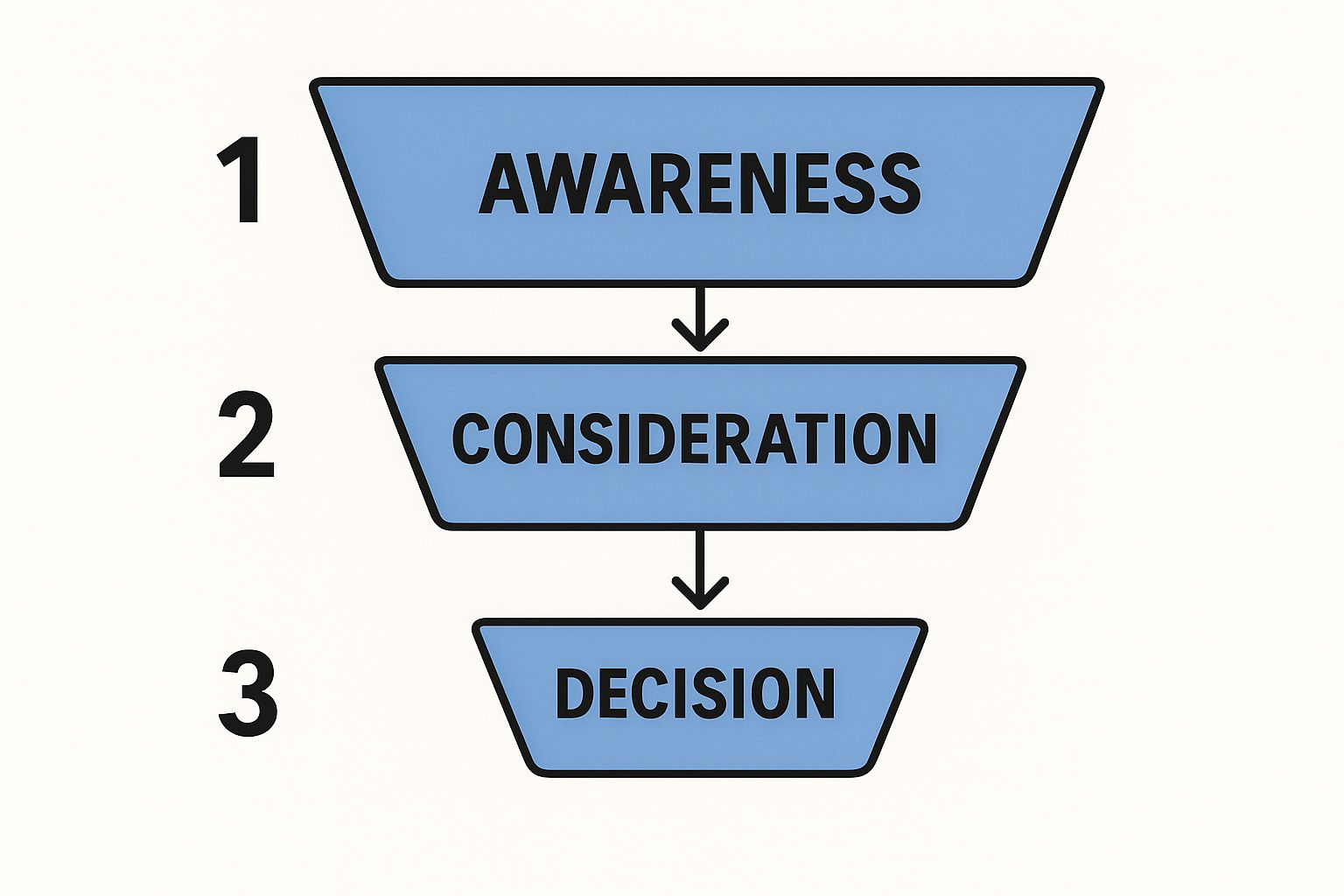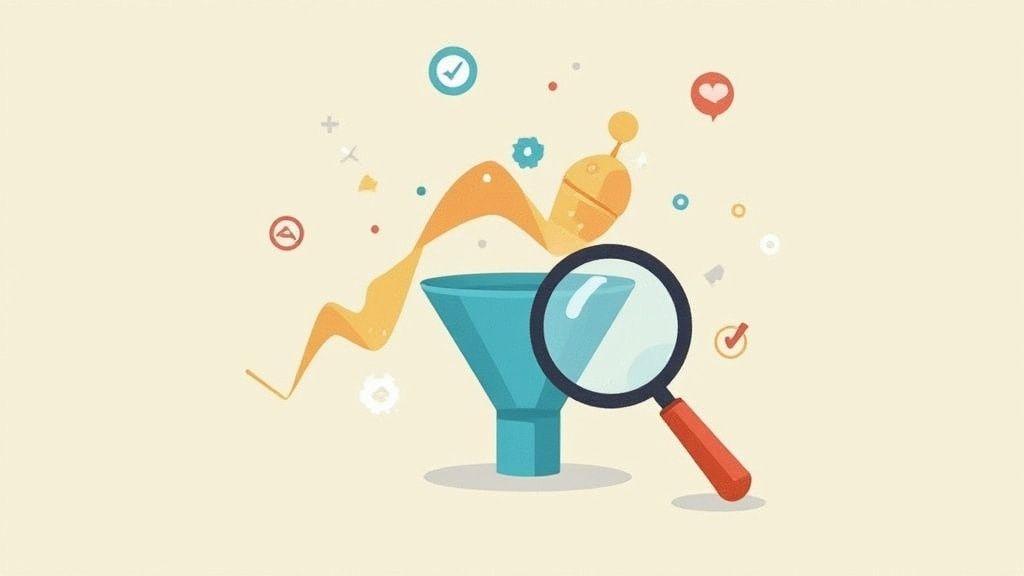What Is Conversion Funnel? Guide to Boost Your Sales

Ever heard of a conversion funnel? It's a way of mapping out the entire journey someone takes, from the very first time they hear about your brand all the way to when they become a customer.
Think of it like an actual funnel. You pour a lot of people in at the top, but as they move down through the different stages, the group gets smaller and smaller. Only the most interested and qualified people make it to the bottom.
Unpacking the Customer Journey
Let's use a real-world example. Imagine you own a coffee shop.
Lots of people walk past your shop every day (Awareness). A smaller group decides to pop their head in to check out the menu (Interest). An even smaller group walks up to the counter, maybe asking about the daily special (Decision). Finally, a handful of them will actually buy a coffee (Action).
That's a conversion funnel in a nutshell. We're just applying that same logic to your website, your social media, and all your other digital marketing efforts.

This simple framework gives you a crystal-clear picture of how people are interacting with your business online. By breaking their journey down into these distinct stages, you can stop guessing and start seeing exactly where you're losing them.
Why It's More Than Just a Model
A conversion funnel isn't just some abstract marketing theory; it's a powerful diagnostic tool for your business. It helps you get inside the heads of your users, spot the weak links in your sales process, and ultimately, get more conversions.
For example, what if you notice you’re getting tons of traffic to your website, but almost no one is signing up for your newsletter? That tells you there’s a major disconnect somewhere in the middle of your funnel. It's a clear signal to start testing changes on that specific step.
This is where a deep understanding of your customer becomes non-negotiable. A detailed target audience analysis is the foundation for building a funnel that actually works.
A well-defined funnel transforms your marketing from a series of disconnected activities into a cohesive, goal-oriented system designed to guide prospects smoothly toward a conversion.
Globally, the average sales funnel conversion rate hovers around 2.35%. That might sound low, but the top-performing companies are hitting rates above 5.31%.
That massive gap shows just how much value there is in mapping out and constantly tweaking your customer's journey.
The Four Core Stages of a Conversion Funnel
To really get a grip on this, let's break down the classic four-stage funnel. It's a simple way to visualize how a stranger becomes a customer.
| Funnel Stage | Primary Goal | Common Activities |
|---|---|---|
| Awareness | Attract attention & introduce your brand | SEO, blog posts, social media, ads, podcasts |
| Interest | Engage prospects & show them you have a solution | Webinars, email newsletters, case studies, downloadable guides |
| Decision | Nurture qualified leads toward a choice | Free trials, product demos, consultations, reviews, pricing pages |
| Action | Convert the lead into a customer | Easy checkout process, clear calls-to-action, promotions |
Each stage requires a different approach. You wouldn't try to sell a product to someone who has never heard of you, just like you wouldn't send a basic "welcome" email to someone ready to buy. Understanding this flow is the key to effective marketing.
Exploring the Four Stages of the Conversion Funnel
To really get a feel for what a conversion funnel is, you have to walk in the customer's shoes. The classic way to map this journey is with the AIDA model, which splits the funnel into four distinct stages: Awareness, Interest, Decision, and Action. Each stage represents a totally different customer mindset, and that means you need to switch up your marketing approach for each one.
It helps to think of it like building a relationship. You wouldn't propose on a first date, right? You start by getting their attention, pique their interest, show them you're a good match, and then you pop the question. The conversion funnel works the exact same way, moving a complete stranger from a first glance to a firm handshake.
Stage 1: Awareness At the Top of the Funnel
This is the widest, most open part of the funnel. It's where potential customers first realize they have a problem and stumble across the idea that you might have a solution. They aren't searching for your product specifically—not yet. They're just looking for answers, information, or even a bit of entertainment related to a pain point they're feeling.
From their side, they're probably Googling things like, "Why is my social media engagement so low?" or "How can I create better marketing visuals?" They’re scrolling through their feeds, listening to podcasts, and just trying to get a handle on the issue.
At this point, your goal isn't to sell. It's to attract and educate. You're casting a wide net to get on the radar of your ideal audience.
- Marketing Activities: This is all about content. Think SEO-optimized blog posts, shareable social media updates, running targeted ad campaigns, or making guest appearances on popular podcasts.
- Customer Action: The user discovers you by reading an article, seeing one of your ads, or watching a quick video.
The trick is to meet them where they already are with genuinely helpful content that positions you as an authority and makes them remember your name.
Stage 2: Interest In the Middle of the Funnel
Okay, you've got their attention. Now what? The next step is to nurture that initial spark into genuine interest. At this stage, people know who you are and have a much clearer picture of the problem they need to solve. They’re now actively digging in, researching, and comparing the different solutions out there.
They've graduated from broad questions to more specific searches. They’re looking for detailed guides, side-by-side product comparisons, or case studies that show off real-world results. This is where you start building that relationship and positioning your offer as the perfect answer to their problem.
This is the crucial handoff where a passive browser becomes an active lead. By offering them something valuable—like a webinar or an ebook—in exchange for their contact info, you earn the right to talk to them directly.
This infographic gives a great visual of how potential customers flow from that first moment of awareness all the way down to a final decision.

You can clearly see how the pool of potential customers gets smaller at each step, which really drives home why it's so important to smooth out every part of the process to keep people from dropping off.
Stage 3: Decision Nearing the Bottom
This is where the magic really starts to happen. Your prospect is now a qualified lead who is seriously thinking about pulling the trigger. They've probably narrowed their options down to you and a couple of competitors, and now they're just trying to figure out the best fit for their needs and budget.
Your job here is to seal the deal. You need to convince them that your solution is, without a doubt, the smartest choice. This is all about building trust and squashing any last-minute doubts.
- Marketing Activities: This is the time to roll out free trials, product demos, in-depth case studies, glowing customer testimonials, and crystal-clear pricing pages.
- Customer Action: The lead signs up for your trial, watches a demo, or pores over customer reviews to make sure they're making the right call.
Stage 4: Action At the Funnel's End
We've reached the narrowest point of the funnel. The lead has made up their mind to buy, and your only job is to make it as easy as possible for them to do it. Any little bit of friction here—a clunky checkout page, surprise fees, or a form that asks for their life story—can spook them into abandoning their cart at the very last second.
This final step is the finish line for all your hard work. A smooth conversion here officially turns a prospect into a customer. By analyzing your conversion funnel, you can track how many people make it through each step, helping you find and fix the leaks that are costing you sales. To get a better sense of how this works, you can learn more about sales funnel conversion rates and see how this data can unlock major growth opportunities.
Why Every Business Needs a Conversion Funnel
Let’s be honest. For many businesses, marketing feels like guesswork. You throw money at different channels, hope something sticks, and try to figure out what’s working after the fact. But what if you had a roadmap?
That's exactly what a conversion funnel is. It’s more than just a buzzwordy marketing model; it’s a diagnostic tool for your entire business. It shows you precisely how people find you, what they do when they get to you, where they get stuck, and ultimately, why they leave. Without that map, you’re flying blind.
A well-defined funnel gives you a clear, data-driven framework for making smarter decisions. Instead of just hoping your ads are working, you can see exactly where your best customers come from and which campaigns are just burning cash. This kind of clarity does wonders for your return on investment (ROI). In fact, research shows that businesses that get serious about lead nurturing—a key part of the funnel—generate 50% more sales-ready leads at a 33% lower cost.
Pinpointing Leaks and Opportunities
Every single business loses potential customers somewhere along the way. That’s a given. The real million-dollar question is where and why.
A conversion funnel breaks down the customer's journey into measurable steps, so you can finally get some answers. Are thousands of people hitting your landing page but only a few are signing up for your newsletter? Your funnel immediately points a giant, flashing arrow at a problem in your Interest stage.
This insight stops you from wasting time and money on broad, ineffective changes. You can zoom in with surgical precision and test specific fixes—like rewriting your call-to-action or simplifying a form—right at the point where people are dropping off. This targeted approach is how you plug the leaks in your bucket.
A conversion funnel turns ambiguity into action. It replaces "I think we have a problem" with "We're losing 70% of users between the interest and decision stages, and here's our plan to fix it."
Building a Predictable Growth Engine
When you really nail your conversion funnel, you shift your business from being reactive to proactive. You stop just responding to what happened last month and start predicting what will happen next.
By understanding the conversion rates at each stage, you can build surprisingly accurate sales forecasts. If you know that for every 1,000 visitors, 10 make a purchase, you can calculate exactly how much traffic you need to generate to hit your next revenue goal. It’s no longer a mystery.
This predictability gives you the power to:
- Allocate Budgets Effectively: Pour resources into the channels and stages that you know deliver the highest value.
- Improve the Customer Experience: Pinpoint the friction points and smooth out the journey, making it easier and more compelling for people to buy.
- Create Repeat Business: The funnel doesn't just stop at the first sale. It provides the perfect framework for nurturing new customers into loyal, repeat buyers who stick around for the long haul.
Ultimately, implementing a conversion funnel gives you a reliable system for growth. It’s the structure you need to consistently attract, engage, and convert customers, turning your marketing from a gamble into a predictable engine for revenue.
Key Metrics to Track at Each Funnel Stage

You can't fix what you don't measure. A conversion funnel is only as good as the data you use to understand it. Tracking the right metrics at each stage helps you spot exactly where people lose interest and drop off. It’s how you move beyond guessing and start making informed decisions.
Think of these metrics as the vital signs of your marketing health. A million impressions looks great on a report, but if no one clicks, it’s just a billboard in an empty desert. You have to connect the numbers to what you’re trying to achieve at each step to get the full story.
Awareness Stage Metrics
Right at the top, the goal is simple: get noticed. You’re essentially asking, "Are we even showing up on the right people's radar?"
- Impressions: This is the most basic count of how many times your content was displayed. It’s a raw measure of your potential audience.
- Traffic Sources: Where are all these visitors coming from? This tells you which channels—like organic search, social media, or paid ads—are actually working to fill your funnel.
- New vs. Returning Visitors: Seeing a steady flow of new visitors means your awareness campaigns are reaching fresh eyes.
If these top-level numbers are low, your brand simply isn't visible enough to the people who might eventually become your customers.
Interest Stage Metrics
Okay, you’ve caught their attention. Now what? The focus shifts to engagement. Are people actually sticking around to see what you have to say? These metrics tell you if your content is hitting the mark.
Your goal here is to transform a passive browser into an active, interested prospect. Success means someone has raised their hand, showing they want to learn more from you.
Key signs of genuine interest include:
- Time on Page: Are people spending real time with your content? Longer sessions suggest they find it genuinely useful.
- Email Sign-ups: This is a huge signal. Someone trusts you enough to hand over their email address.
- Click-Through Rate (CTR): Are users clicking your calls-to-action to explore other pages or download resources?
For a deeper dive, a comprehensive guide on https://www.lumeo.me/en/blog/measuring-content-performance can help you unpack these crucial engagement signals.
Decision Stage Metrics
At this point, you’re on the shortlist. Potential customers are actively weighing their options, and your product is one of them. The big question is, "Are we doing enough to prove our value and earn their trust?"
Metrics here get much more specific and closer to the sale. You'll want to watch numbers like product page views, free trial sign-ups, and items added to the shopping cart.
One of the most critical metrics here is the cart abandonment rate. The industry average hovers around a staggering 70%, so a high rate is a massive red flag that something in your checkout process is scaring people away.
Action Stage Metrics
This is it—the finish line. The goal is straightforward: turn that interested lead into a happy, paying customer. The metrics at this final stage are tied directly to your bottom line.
- Conversion Rate: The percentage of visitors who actually complete the purchase. This is the ultimate test of your funnel's effectiveness.
- Average Order Value (AOV): On average, how much does a customer spend in a single transaction?
- Customer Lifetime Value (CLV): This forecasts the total revenue you can expect from a single customer over the entire course of your relationship.
Of course, the journey doesn't end at the sale. Understanding how customers feel after they buy is key to retention. You can explore various customer satisfaction measurement methods to keep them coming back.
Funnel Stage Metrics and Key Questions Answered
To tie it all together, here's a quick-glance table that connects the dots between each funnel stage, the metrics to watch, and what those numbers are actually telling you about your business.
| Funnel Stage | Key Metrics | What It Tells You |
|---|---|---|
| Awareness | Impressions, Reach, Traffic Sources, New vs. Returning Visitors | "Are we reaching enough of the right people?" |
| Interest | Time on Page, Bounce Rate, Email Sign-ups, Click-Through Rate (CTR) | "Is our content engaging enough to hold their attention?" |
| Decision | Product Page Views, Free Trial Sign-ups, Cart Additions, Cart Abandonment Rate | "Are we effectively demonstrating value and building trust to buy?" |
| Action | Conversion Rate, Average Order Value (AOV), Customer Lifetime Value (CLV) | "Are we successfully turning leads into profitable customers?" |
This framework gives you a clear lens through which to view your performance. By monitoring these KPIs, you can pinpoint weaknesses and focus your efforts where they'll have the biggest impact.
Actionable Strategies to Optimize Your Funnel
Knowing what a conversion funnel is doesn't automatically mean yours is working. The real magic happens when you start optimizing it to drive actual growth.
The first step is always spotting where people are dropping off. But finding the leaks is just the beginning—plugging them requires specific, targeted actions at each stage. It's time to turn that data into a concrete game plan.
Let’s move from theory to practice. Here are some proven strategies to tighten up your funnel from top to bottom.
Refining the Top of Your Funnel: Awareness
Right at the start, your goal is simple: attract the right kind of attention. It’s not about getting a flood of random traffic. It’s about drawing in people who could actually become customers. If your funnel is empty at the top, nothing else you do matters.
- Improve Your SEO: Get inside your customer's head. What are they typing into Google? Use keyword research to create blog posts and landing pages that answer those exact questions. This immediately positions you as a helpful guide.
- Create Shareable Content: Think visually. Infographics, short videos, and eye-catching images are gold on social media. When you create something genuinely useful or entertaining, your audience does the marketing for you by sharing it.
Engaging Prospects in the Interest Stage
Okay, you’ve got their attention. Now you have to earn their trust. The Interest stage is your chance to transform a casual browser into someone genuinely engaged with your brand. This is where you prove you’re the solution they’ve been looking for.
The goal here is to open a direct line of communication. By offering something valuable in exchange for an email, you get their permission to continue the conversation—away from the noise of search results and social feeds.
The best way to do this? Create a lead magnet they can't refuse. This could be a detailed ebook, a handy checklist, an exclusive webinar, or a free template. The key is to offer something so valuable that they are happy to trade their contact info for it.
Building Trust During the Decision Stage
At this point, your leads are weighing their options. They know who you are and what you do, but they need that final nudge to feel confident choosing you. Your job is to erase any doubt and make your solution the obvious choice.
- Leverage Social Proof: Let your happy customers do the selling. Plaster your product and pricing pages with customer testimonials, case studies, and positive reviews. Seeing that other people have already found success with you is incredibly persuasive.
- Offer Demos or Free Trials: Let them kick the tires. A risk-free trial or a hands-on demo is one of the most powerful ways to overcome objections. It lets the product speak for itself in a way no sales page ever could.
For more hands-on tactics, check out these practical conversion rate optimization ideas.
Simplifying the Final Action Stage
You’ve guided them all the way to the finish line—don’t fumble the ball now. The Action stage needs to be dead simple. Any friction, confusion, or extra step is an invitation for them to leave.
- Streamline Your Checkout: Cut the fat. Only ask for the absolute essentials. Offer a guest checkout option, kill any unnecessary steps, and show all costs upfront. No one likes surprises when their wallet is out.
- Automate Nurture Sequences: Not everyone buys on the first try. That’s where marketing workflow automation comes in. Set up automated emails to follow up with abandoned carts or re-engage hesitant buyers with a timely reminder or a helpful nudge.
Got Questions About Conversion Funnels? Let's Clear Things Up.
As you start sketching out your own customer journeys, a few questions always seem to pop up. It's totally normal. Getting the hang of the finer points of conversion funnels is what separates a good strategy from a great one.
Let's tackle some of the most common points of confusion head-on.
What’s the Real Difference Between a Sales Funnel and a Marketing Funnel?
This is a classic, and honestly, the answer has changed over the years.
Traditionally, you had the marketing funnel, which was all about the top of the pyramid—casting a wide net to build awareness and bring in leads. Its whole job was to get people interested and hand them off.
Then, the sales funnel would kick in. This was the bottom part of the journey, focused on turning those interested leads into actual customers. Think demos, proposals, and closing the deal.
But today? The line is incredibly blurry. Most successful businesses now see it as one single, seamless conversion funnel. Marketing and sales have to work in lockstep to guide a person from "Who are you?" to "Here's my money."
The easiest way to think about it is that marketing builds the relationship, and sales finalizes the commitment. Both are critical players on the same team, working toward the same goal.
How Long Does It Actually Take to Build a Good Funnel?
This is not a "set it and forget it" kind of thing. Sure, you can throw together a basic funnel—a landing page, an email opt-in, and a few automated messages—in a couple of days. But building a funnel that's genuinely effective and optimized? That's an ongoing project.
The timeline really hinges on a few things:
- Complexity: A simple funnel to capture email sign-ups is way faster to build than a sprawling e-commerce funnel with multiple products, upsells, and abandoned cart sequences.
- Content Creation: Don't forget, your funnel needs fuel. Crafting high-quality blog posts, videos, lead magnets, and emails all takes time and effort.
- Testing and Optimization: The real work starts after you launch. It can take months of A/B testing, pouring over data, and plugging leaks to really get your conversion rates humming.
So, plan on spending a few weeks for the initial setup, but be ready to commit to constantly tweaking and improving it based on what the numbers tell you.
What Are the Best Tools for Tracking a Conversion Funnel?
You can't fix what you can't see. Thankfully, there are some fantastic tools out there to give you a clear picture of how your funnel is performing.
The absolute best place to start is Google Analytics. It’s free, powerful, and lets you set up goals to track how users move through your funnel, showing you exactly where they drop off.
For a more visual, "over-the-shoulder" look, tools like Hotjar are brilliant. They provide heatmaps and session recordings so you can literally watch how people interact with your pages.
Finally, for the middle and bottom of your funnel, a good CRM and email marketing platform is non-negotiable. Tools like HubSpot or Mailchimp are essential for tracking how leads are progressing and engaging with your emails and sales outreach.
Ready to create stunning content for the top of your funnel? Lumeo helps you transform any text into eye-catching carousels that stop the scroll and build brand awareness. Start creating for free on Lumeo.